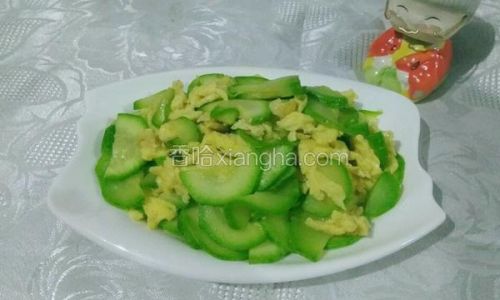Table of content
Stir-fried round gourd, a dish deeply rooted in Asian culinary traditions, is a testament to the beauty of simplicity and flavor. Often overlooked in Western kitchens, this vegetable—known as Lagenaria siceraria or bottle gourd—boasts a mild, slightly sweet taste and a crisp texture that lends itself beautifully to high-heat cooking methods. When stir-fried with aromatic ingredients, it transforms into a vibrant, nutrient-packed meal that delights the palate and nourishes the body. This article delves into the intricacies of preparing stir-fried round gourd, offering a comprehensive guide to achieving restaurant-quality results at home. From selecting the freshest produce to mastering the balance of flavors, we will explore every facet of this dish, ensuring even novice cooks can confidently recreate it in their kitchens.

Understanding the Round Gourd
Before diving into the cooking process, it is essential to appreciate the round gourd’s unique characteristics. This versatile vegetable, also called calabash or opo squash, is native to Africa but has become a staple in Asian, Middle Eastern, and Caribbean cuisines. Its pale green, smooth skin encases a tender, spongy flesh that absorbs flavors readily, making it an ideal candidate for stir-fries, soups, and curries. Nutritionally, round gourd is a powerhouse, rich in dietary fiber, vitamins C and B6, and essential minerals like iron and magnesium. Its high water content (approximately 96%) contributes to its refreshing crunch and low-calorie profile, making it a guilt-free addition to any meal.
Ingredients: Building Blocks of Flavor
The success of any stir-fry hinges on the quality of ingredients and their harmonious interplay. For this recipe, we will focus on a classic preparation that highlights the gourd’s natural sweetness while layering in umami-rich and aromatic elements. Here’s a breakdown of the key components:
- Round Gourd (1 medium, approximately 600–700 grams): Choose a firm, unblemished gourd with vibrant green skin. Avoid specimens with soft spots or wrinkled surfaces, as these indicate age or spoilage.
- Aromatics:
- Garlic (4 cloves, minced): Adds pungent depth.
- Ginger (1-inch piece, grated): Imparts a warm, citrusy note.
- Fresh red chili (1–2, thinly sliced): Adjust to taste for heat.
- Cooking Oil (2 tablespoons): Use a neutral oil like vegetable or peanut oil, which can withstand high heat without smoking.
- Sauce Base:
- Soy sauce (1 tablespoon): Provides saltiness and umami.
- Oyster sauce (1 teaspoon): Enhances richness (substitute with mushroom sauce for a vegetarian alternative).
- Rice vinegar (1/2 teaspoon): Balances sweetness with a subtle tang.
- Sugar (1/2 teaspoon): Amplifies the gourd’s natural sweetness.
- Cornstarch Slurry (1 teaspoon cornstarch + 1 tablespoon water): Thickens the sauce for a glossy finish.
- Optional Garnishes:
- Toasted sesame seeds
- Fresh cilantro or Thai basil
- Sliced scallions
Preparation: The Foundation of Excellence
Stir-frying is a rapid cooking method that demands precision and organization. Prepping ingredients in advance ensures a seamless cooking process and prevents overcooking.
Preparing the Round Gourd
- Peeling: Use a vegetable peeler to remove the gourd’s tough outer skin. Work carefully to avoid removing excessive flesh.
- Halving and Seeding: Slice the gourd in half lengthwise. Use a spoon to scoop out the soft, seed-filled center. Discard the seeds or reserve them for composting.
- Cutting: Slice the gourd into thin, even half-moons or batons (approximately 1/4-inch thick). Uniformity ensures even cooking.
Mise en Place
- Mince the garlic and grate the ginger.
- Thinly slice the chili, removing seeds for milder heat.
- Whisk together the soy sauce, oyster sauce, rice vinegar, and sugar in a small bowl.
- Prepare the cornstarch slurry in a separate dish.
Cooking Process: Mastering the Stir-Fry
Stir-frying is an art that combines science and intuition. The goal is to cook the gourd quickly over high heat, preserving its texture while caramelizing its natural sugars.
Heating the Wok or Skillet
- Place a wok or large skillet over high heat. Allow it to preheat for 2–3 minutes until a drop of water evaporates instantly upon contact.
- Add the oil and swirl to coat the pan evenly.
Sautéing Aromatics
- Add the garlic, ginger, and chili to the hot oil. Stir-fry for 15–20 seconds until fragrant but not browned. Overcooking aromatics can introduce bitterness.
Adding the Round Gourd
- Toss the sliced gourd into the pan. Use a spatula to distribute it evenly, ensuring maximum contact with the hot surface.
- Stir-fry for 3–4 minutes, stirring continuously. The gourd will begin to soften and turn translucent.
Incorporating the Sauce
- Pour the sauce mixture over the gourd. Stir vigorously to coat each piece. The sauce will reduce slightly, clinging to the gourd.
- Reduce the heat to medium-low and cover the pan. Allow the gourd to steam for 2–3 minutes, or until tender but still slightly crisp.
Thickening the Sauce
- Uncover the pan and increase the heat to high. Pour in the cornstarch slurry while stirring continuously. The sauce will thicken within 30 seconds, forming a glossy coating.
- Remove from heat immediately to prevent overcooking.
Serving Suggestions: Elevating the Dish
Stir-fried round gourd pairs beautifully with a variety of accompaniments, making it a versatile addition to any meal:

- Steamed Rice: The gourd’s mild flavor complements the neutrality of jasmine or basmati rice.
- Noodles: Toss with udon or soba noodles for a heartier dish.
- Protein Boost: Serve alongside grilled tofu, shrimp, or sliced chicken for a complete meal.
- Garnishes: A sprinkle of toasted sesame seeds or fresh herbs adds texture and freshness.
Variations and Customizations
One of the joys of stir-frying is its adaptability. Experiment with these variations to suit your taste:
- Spicy Kick: Add a teaspoon of chili paste or Sichuan peppercorns during the aromatics stage.
- Fermented Flavors: Incorporate a splash of black vinegar or fermented bean paste for depth.
- Vegetable Medley: Introduce bell peppers, snap peas, or mushrooms for added color and nutrition.
- Nutty Crunch: Top with crushed peanuts or cashews before serving.
Troubleshooting Common Pitfalls
Even seasoned cooks encounter hiccups in the kitchen. Here’s how to address common issues:
- Soggy Gourd: Ensure the pan is adequately preheated, and avoid overcrowding the vegetables. Cook in batches if necessary.
- Bland Flavor: Increase the soy sauce or add a pinch of salt. Balance with a touch more sugar if needed.
- Burnt Aromatics: Keep a close eye on the garlic and ginger. Remove the pan from heat immediately if they begin to brown.
The Health Benefits of Stir-Fried Round Gourd
Beyond its culinary appeal, stir-fried round gourd offers a wealth of health benefits:
- Hydration: Its high water content aids digestion and promotes skin health.
- Antioxidants: Rich in vitamin C, it combats oxidative stress and boosts immunity.
- Low-Calorie: A 100-gram serving contains just 15 calories, making it ideal for weight management.
- Digestive Health: The fiber content supports gut health and regulates blood sugar levels.
Conclusion: A Dish Worth Mastering
Stir-fried round gourd is more than a meal—it’s a celebration of simplicity and balance. By honoring the ingredient’s natural qualities and mastering the nuances of stir-frying, you can create a dish that is both humble and extraordinary. Whether served as a side or a main course, this recipe invites creativity and adaptation, ensuring it remains a timeless favorite in your culinary repertoire. So grab your wok, sharpen your knife, and embark on a journey to savor the delicate artistry of stir-fried round gourd. Your taste buds—and your body—will thank you.





0 comments